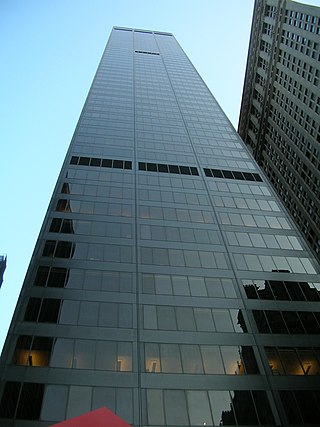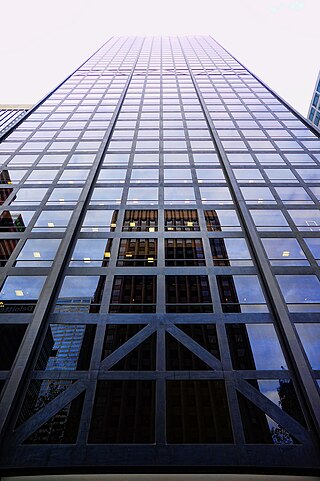140 William Street may refer to:
140 William Street may refer to:
Several places in the German-speaking area are named Nassau, but most places and things named Nassau ultimately derive their name from the town of Nassau on the Lahn in Rhineland-Palatinate, after which the region and the House of Nassau are named. In German, nass means "wet" and Au can be a short form of either Flussaue (floodplain) or Auwald. It can also be used as a synonym for Feuchtwiese. Aue derives from Middle High German ouwe, which is related to the Latin aqua ("water").

The City and South London Railway (C&SLR) was the first successful deep-level underground "tube" railway in the world, and the first major railway to use electric traction. The railway was originally intended for cable-hauled trains, but owing to the bankruptcy of the cable contractor during construction, a system of electric traction using electric locomotives—an experimental technology at the time—was chosen instead.
Interstate 140 may refer to:
Wall Street is a street which runs through the Financial District of New York City, which due to many financial centers being located on the street is further a metonym for the Economy of the United States.

140 Broadway is a 51-story International Style office building on the east side of Broadway between Cedar and Liberty streets in the Financial District of Manhattan in New York City. The building was designed by Gordon Bunshaft, of the firm Skidmore, Owings & Merrill, and consists of a mostly smooth black facade on a trapezoidal plot. It is approximately 688 feet (210 m) tall, with approximately 1.17 million rentable square feet (109,000 m2). It is known for the distinctive sculpture at its entrance, Isamu Noguchi's Cube.
King's Highway 140, commonly referred to as Highway 140, is a provincially maintained highway in the Canadian province of Ontario. The highway connects Port Colborne near Lake Erie with Highway 406 in Welland, via the Main Street Tunnel. It was constructed in the early 1970s as part of the Welland Bypass project of the Welland Canal, which resulted in the severance of several highways and rail lines. Opened to traffic in late 1972, several months following the tunnel, Highway 140 has remained unchanged since, despite growing calls to resign it as an extension of Highway 406.

William Street is a major street in the Melbourne central business district, Victoria, Australia. It runs roughly north–south from Flinders Street to Victoria Street, and was laid out in 1837 as part of the original Hoddle Grid. The street is located in-between King Street and Queen Street.

Nassau Street is in the Financial District, within the borough of Manhattan in New York City. Its southern end is at the intersection with Broad Street and Wall Street, and its northern end is at Spruce Street, at Pace University near the foot of the Brooklyn Bridge. For its entire route, Nassau Street runs one block east of Broadway and Park Row.

Maryland Route 140 is a 49-mile (79 km) state highway in the U.S. state of Maryland. The route runs from U.S. Route 1 and US 40 Truck in Baltimore northwest to the Pennsylvania border, where the road continues into that state as Pennsylvania Route 16. MD 140 passes through the northern part of central Maryland, connecting Baltimore, Pikesville, Reisterstown, Westminster, Taneytown, and Emmitsburg.

140 William Street is a 41-storey steel, concrete and glass building located in the western end of the central business district of Melbourne, Victoria, Australia. Constructed between 1969 and 1972, BHP House was designed by the architectural practice Yuncken Freeman alongside engineers Irwinconsult, with heavy influence of contemporary skyscrapers in Chicago, Illinois. The local architects sought technical advice from Bangladeshi-American structural engineer Fazlur Rahman Khan, of renowned American architectural firm Skidmore, Owings & Merrill, spending ten weeks at its Chicago office in 1968. At the time, BHP House was known to be the tallest steel-framed building and the first office building in Australia to use a “total energy concept” – the generation of its own electricity using BHP natural gas. The name BHP House came from the building being the national headquarters of BHP. BHP House has been included in the Victorian Heritage Register for significance to the State of Victoria for following three reasons:
Stilbe in Greek mythology may refer to the following personages:

A series of bombings were carried out or attempted by Galleanists from April through June 1919. The targets included anti-immigration politicians, anti-anarchist officials, and prominent businessmen, as well as a journalist and a church. Almost all of the bombs were sent by mail. The bombings were one of the major factors contributing to the First Red Scare. Two people were killed, including one of the bombers, and two injured.
In Greek mythology, the name Alcimus or Alkimos may refer to:

140 William Street, Perth is a commercial development in Perth, Western Australia.
New Objectivity was an art movement that emerged in Germany in the early 1920s as a counter to expressionism. The term applies to a number of artistic forms, including film.

William Patrick Roache is an English actor, best known for playing Ken Barlow in the ITV soap opera Coronation Street. Roache is the longest-serving cast member in Coronation Street having appeared in the show since its very first broadcast on 9 December 1960. He is listed in the Guinness World Records as the longest-serving television star in a continuous role.

130 West 57th Street is an office building on 57th Street between Sixth Avenue and Seventh Avenue in Midtown Manhattan in New York City. It was built from 1907 to 1908 and designed by Pollard and Steinam, who also simultaneously designed the neighboring, nearly identical building at 140 West 57th Street. The buildings are among several in Manhattan that were built in the early 20th century as both studio and residences for artists.

140 West 57th Street, also known as The Beaufort, is an office building on 57th Street between Sixth Avenue and Seventh Avenue in Midtown Manhattan in New York City. It was built from 1907 to 1909 and designed by Pollard and Steinam, who also simultaneously designed the neighboring, nearly identical building at 130 West 57th Street. The buildings are among several in Manhattan that were built in the early 20th century as both studio and residences for artists.